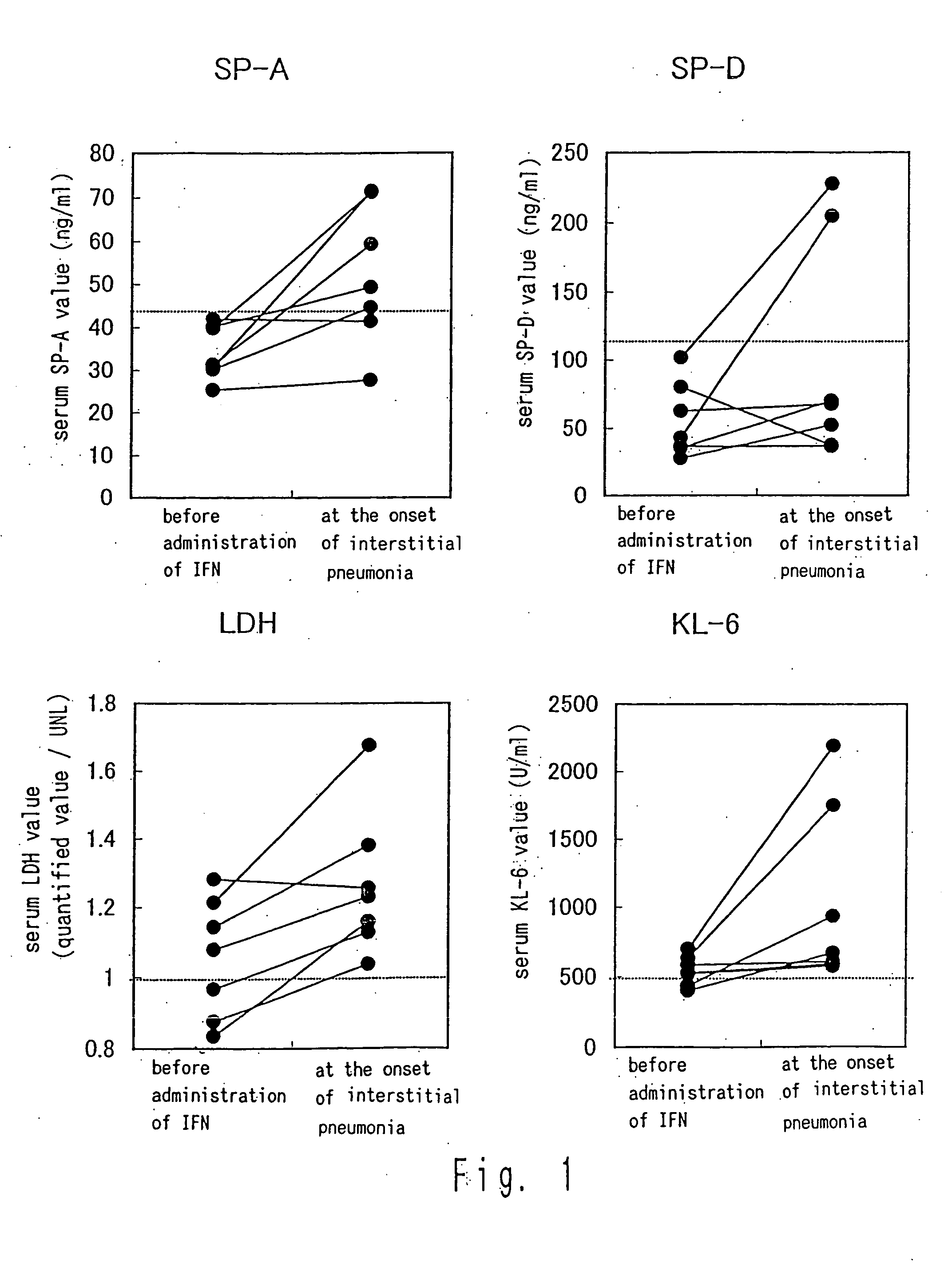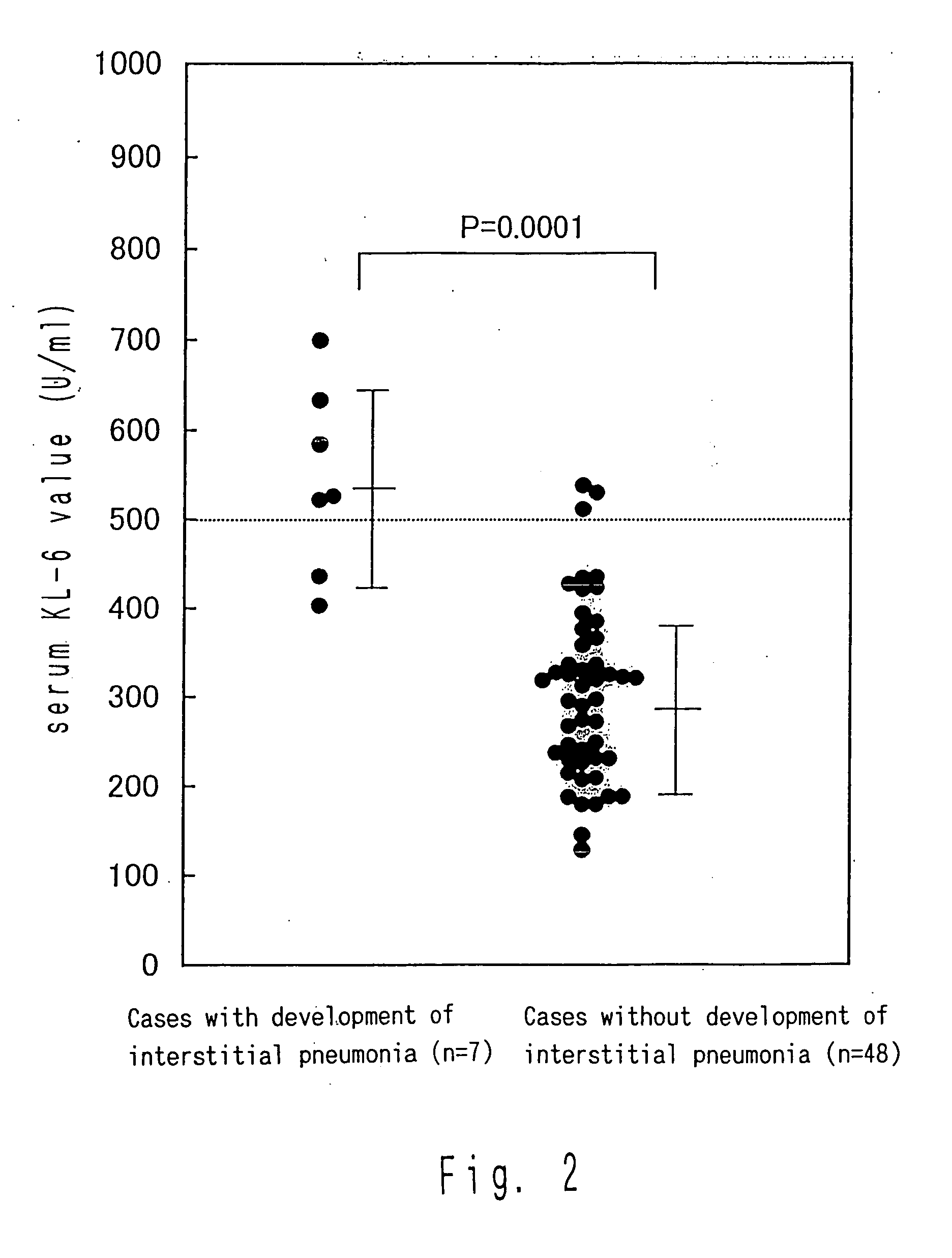Method for predicting development of interstitial pneumonia by quantifying MUC-1
- Summary
- Abstract
- Description
- Claims
- Application Information
AI Technical Summary
Benefits of technology
Problems solved by technology
Method used
Image
Examples
example 1
Backgrounds of Patients
[0043] The analyzed patients are 558 chronic hepatitis C patients provided with the administration of interferon-α from January 1992 to July 2000 in the alimentary division of Tokyo hospital of National Sanatoria. Among those, six patients (1.1%) developed interstitial pneumonia, which includes patients who received the administration of ribavirin and patients who did not receive the same. Among them, one patient (Case 5) developed interstitial pneumonia in 1993 during the administration of interferon-a, and after recovery, the patient received combined therapy of interferon-α-2b and ribavirin, and developed interstitial pneumonia again in 2002. During nine years before the development of interstitial pneumonia again, the patient did not surfer from a respiratory system disorder. Thus, the two developments were handled as two independent cases (5-1 and 5-2).
[0044] Diagnostic criteria for interstitial pneumonia developed by the administration of interferon ar...
example 2
Quantification of MUC-1 (KL-6), LDH, SP-A, and SP-D in Six Cases in Which Interstitial Pneumonia was Developed
[0048] In the following examples, MUC-1 value is quantified with KL-6 antibody and thus the MUC-1 value is described as KL-6. A serum sample was stored at −80° C. and used for the quantification described below.
[0049] The KL-6 in serum was quantified using commercially-available EIA kit (Eitest KL-6, manufactured by Sanko Junyaku Co., Ltd.). Similarly, the SP-A in the serum was quantified as described in the method reported in Kuroki Y et al. Am Rev Resir Dis. 147:723-729, and the SP-D was quantified using commercially-available EIA kit (SP-D EIA Kit, manufactured by Yamasa Corporation). The maximum values (UNLs) of the respective normal values are 500 U / ml for MUC-1, 43.8 ng / ml for SP-A, and 110 ng / ml for SP-D.
[0050] Furthermore, at that time, the calculation was performed under the conditions in which the UNL of LDH was 399 IU / I until September, 1993 and 474 IU / I therea...
example 3
Comparison of KL-6 Values Before the Administration of Interferon Between Cases in Which Interstitial Pneumonia was Developed due to the Administration of Interferon and Cases Without the Development Thereof
[0053] Of the cases in which interstitial pneumonia was developed due to the administration of interferon, many cases were observed in which KL-6 exhibited an abnormally high value even before the administration of interferon. Thus, from among patients not younger than the youngest patients (age 54 in Cases 3 and 6) who developed interstitial pneumonia, 48 chronic hepatitis C patients who did not develop interstitial pneumonia due to the administration of interferon were randomly sampled and subjected to the measurement of the KL-6 value before the administration. The results compared with those of the cases in which interstitial pneumonia was developed are shown in FIG. 2.
[0054] The abnormally high value was found in five out of seven cases (71%) with the development of inters...
PUM
 Login to View More
Login to View More Abstract
Description
Claims
Application Information
 Login to View More
Login to View More - R&D
- Intellectual Property
- Life Sciences
- Materials
- Tech Scout
- Unparalleled Data Quality
- Higher Quality Content
- 60% Fewer Hallucinations
Browse by: Latest US Patents, China's latest patents, Technical Efficacy Thesaurus, Application Domain, Technology Topic, Popular Technical Reports.
© 2025 PatSnap. All rights reserved.Legal|Privacy policy|Modern Slavery Act Transparency Statement|Sitemap|About US| Contact US: help@patsnap.com


